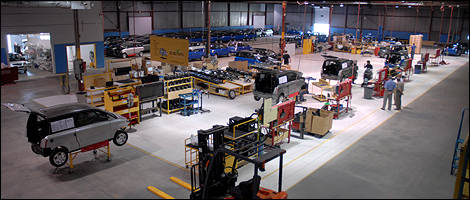Quebec's Minister of Transport, Julie Boulet, recently announced a pilot project allowing low-speed vehicles (LSV) to circulate on specific roads starting July 17. LSVs will be limited to city streets and roads with a speed limit of 50 km/h or under.
In La Belle Province, only two such vehicles have received the green light from the government: a small urban pickup truck called Nemo (built in St. Therese) and a subcompact two-seater called ZENN (manufactured in St. Jerome). Gilles Allard, Vice President of Production at ZENN Motor Company, worked closely with Mrs. Boulet to develop the project.
For the past two years, electric cars produced by ZENN have been sold throughout the United States and, more recently, in British Columbia -- but not in Quebec. Now, things will be different and Mr. Allard couldn't be more proud.
The popularity of LSVs is on steady rise, especially as of late. In fact, nearly 200 Quebecers have shown interest in the ZENN since the announcement. Only time will tell if they truly are willing to pay over $15,000 for this car.
A tour of the facility
We had the opportunity to visit the ZENN assembly plant, where the current capacity is three units a day. With the increasing demand, the facility and its workers will be able to produce up 30 cars a day. Right now, the entire process takes about 16 hours (or two work shifts) for a single ZENN. Of course, St. Jerome is only responsible for the assembly; every component is manufactured elsewhere before being shipped here.
The chassis comes from a Nantes-based company called Microcar. Upon arriving in Canada, it already looks like a car, with paint being applied and several components being installed, such as the windows, wheels, headlights and seats.
Workers begin by mounting the batteries in a specific compartment under the rear cargo floor. A rack is also fitted up front to receive additional batteries.
Next, they put the electric motor and the various energy management systems in place. Once this is done, the assembly is almost complete. In order to validate battery output and the performance of numerous components, the car is put on dynamometer until the batteries run out.
 |
In La Belle Province, only two such vehicles have received the green light from the government: a small urban pickup truck called Nemo (built in St. Therese) and a subcompact two-seater called ZENN (manufactured in St. Jerome). Gilles Allard, Vice President of Production at ZENN Motor Company, worked closely with Mrs. Boulet to develop the project.
For the past two years, electric cars produced by ZENN have been sold throughout the United States and, more recently, in British Columbia -- but not in Quebec. Now, things will be different and Mr. Allard couldn't be more proud.
The popularity of LSVs is on steady rise, especially as of late. In fact, nearly 200 Quebecers have shown interest in the ZENN since the announcement. Only time will tell if they truly are willing to pay over $15,000 for this car.
A tour of the facility
We had the opportunity to visit the ZENN assembly plant, where the current capacity is three units a day. With the increasing demand, the facility and its workers will be able to produce up 30 cars a day. Right now, the entire process takes about 16 hours (or two work shifts) for a single ZENN. Of course, St. Jerome is only responsible for the assembly; every component is manufactured elsewhere before being shipped here.
The chassis comes from a Nantes-based company called Microcar. Upon arriving in Canada, it already looks like a car, with paint being applied and several components being installed, such as the windows, wheels, headlights and seats.
Workers begin by mounting the batteries in a specific compartment under the rear cargo floor. A rack is also fitted up front to receive additional batteries.
Next, they put the electric motor and the various energy management systems in place. Once this is done, the assembly is almost complete. In order to validate battery output and the performance of numerous components, the car is put on dynamometer until the batteries run out.
 |





